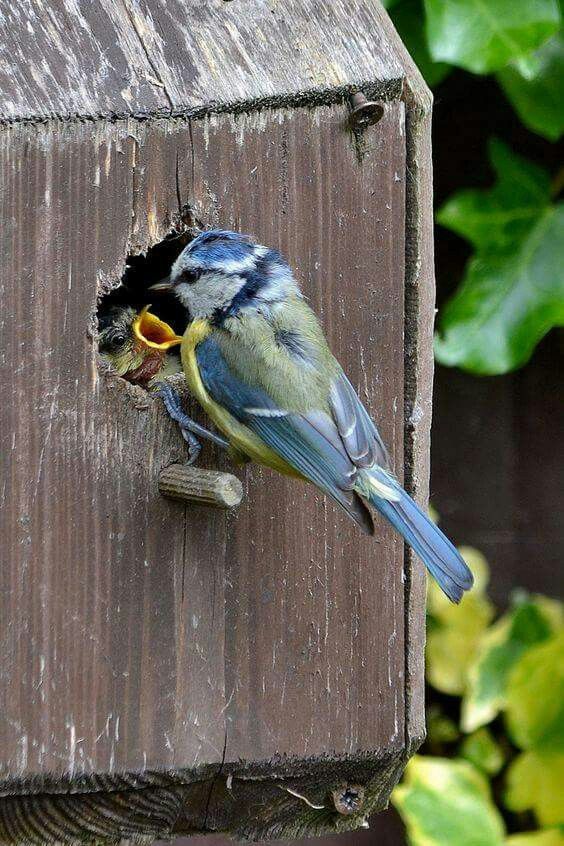Feeding baby bluejays
Baby Blue Jays: All You Need To Know
What does a baby Blue jay look like?
How big are baby Blue jays?
Why do you never see baby Blue jays?
What is a baby Blue jay called?
What do baby Blue jays eat?
Do both parents feed baby Blue jays?
What do Blue jay eggs look like?
How long do Blue jay eggs take to hatch?
How many babies does a Blue jay have?
When do Blue jays lay eggs?
How do Blue jays feed their chicks?
How long do baby Blue jays stay with their parents?
Do Blue jays have helpers?
Blue jays (Cyanocitta cristata) have beautiful cobalt-blue plumage and distinctive head crests - they’re the most colorful of all the corvids and one of the most recognisable birds in North America.
Like all corvids, Blue jays are intelligent and resourceful, but what about baby Blue jays? This is a guide to everything you need to know about baby Blue jays!
What does a baby Blue jay look like?
Baby Blue jays are tiny when they hatch and are mainly grey with faint shades of yellow and pink. They’re blind with closed eyes and may be covered in small featherless naked patches.
At hatching
Baby Blue jays are mostly feathered when they hatch but may have naked featherless patches. They’re predominantly grey with pink/yellow plumage on their underside. Their eyes are shut and don’t open for the first 4 to 5 days.
While baby Blue jays will only squirm on their first day, they can shuffle around the nest by day 2. Blue jay hatchlings are tiny, just 50mm long or so.
Blue jay feeding chicks in the nest
Growth and development
Blue jays grow rapidly in their first five days, and their plumage gets noticeably darker, turning to olive. Blue feathers don’t start breaking out until day 14 or so and continue to grow until day 20 or so, at which point the jay fledges.
Full blue plumage development isn’t complete for another month or so after fledging. However, juvenile Blue jays are relatively easy to identify by their blue-grey plumage and buff, fluffy feathers.
A pair of recently fledged blue jays
How big are baby Blue jays?
Baby Blue jays weigh around 5.5g at hatching with a body length of just 51 mm. By the fifth day, Blue jays already weigh approximately 20 to 28g and measure about 76 mm.
Why do you never see baby Blue jays?
Baby Blue jays won’t leave the nest for 17 to 22 days but are unable to fly for another week or so after fledging.
Once fledged, the chicks remain close to their parents. The parents often relocate away from the nest while staying within the confines of deep treetop foliage.
Blue jay fledglings are vulnerable and are pretty easy to spot if they’re roaming around on the ground. However, if you spot one, its parents are probably watching it (and you!) from a treetop perch, so think twice before touching or relocating it.
A blue jay fledgling on the ground
What is a baby Blue jay called?
There is no specific name for baby Blue jays. Just after they hatch, Baby Blue jays are called hatchlings. Then, they develop into nestlings while they spend all of their time in the nest. Finally, baby Blue jays become fledglings, juveniles, and fully grown adults.
Then, they develop into nestlings while they spend all of their time in the nest. Finally, baby Blue jays become fledglings, juveniles, and fully grown adults.
What do baby Blue jays eat?
Baby Blue jays eat whatever their parents bring them, including insects, berries, seeds and grains. While Blue jays also eat meat in the form of small animals and other birds, the young are unlikely to be able to digest it. Soft foods are preferable.
In the first few days after hatching, the male provides the vast majority of food, but the female will join if his haul is insufficient. Then, after a few days, the female typically joins the male to forage more feed for the hungry chicks.
After that, the male usually feeds the nestlings too, but the female has been observed reaching into the chicks’ mouths and redistributing food.
A blue jay feeding one of their chicks
Do both parents feed baby Blue jays?
In the first few days after hatching, the male does most of the foraging and feeds the nestlings. However, the female will often forcibly redistribute food by reaching into the nestlings’ mouths.
However, the female will often forcibly redistribute food by reaching into the nestlings’ mouths.
After around 4 to 5 days, the female typically joins the male. As the birds approach fledging, both birds feed the chicks. Parental feeding carries on for a week or two after the baby Blue jays fledge.
What do Blue jay eggs look like?
Blue jay eggs typically measure 28 mm x 20 mm and are predominantly ovular. colors vary from shades of blue, to green, olive and light brown.
They’re spotted or blotched with brownish markings, mainly towards the larger end. So while Blue jay eggs look similar to most corvid eggs, they vary a lot, especially regarding their color and shape.
A juvenile blue jay, perched on the fence
How long do Blue jay eggs take to hatch?
Blue jay eggs are incubated for around 17 to 18 days before hatching.
How many babies does a Blue jay have?
Female Blue jays typically lay between 2 to 7 eggs, but 4 to 5 is more common. It would be rare for all chicks to survive until adulthood.
It would be rare for all chicks to survive until adulthood.
When do Blue jays lay eggs?
Blue jays almost solely lay eggs in the months of March, April and May.
May egg-laying usually only occurs in the north, or when it’s particularly cold. In the south, egg-laying may start as early as early March, but rarely earlier.
- Michigan: early May
- Minnesota: late April
- Kentucky and Kansas: Mid April
- Arkansas: late March
- Florida: Early March
Three Blue Jay fledglings perched in a tree together
How do Blue jays feed their chicks?
Blue jay parents are presumed to partially regurgitate harder foods into the chicks' mouths, but probably feed most foods to the chicks whole. Larger pieces of food will be torn up before feeding.
Baby Blue jays are fed with berries, insects and seeds. Insects are ideal as they’re soft and high in protein and fats.
How long do baby Blue jays stay with their parents?
Blue jays fledge after just 17 to 21 days after hatching in most cases, but they’ll stay very close to the nest (within 25m or so usually) for another 2 to 3 weeks.
After that, young Blue jays usually stay within the family unit for another 2 to 3 months, at which point they’ve grown out most of their adult plumage and fly off to establish independent territories. Baby Blue jays often continue to harass their parents for food long into summer.
Close up of a baby blue jay
Do Blue jays have helpers?
Helpers are single unpaired birds that help a pair of birds with everything from nest building and incubation to brooding and feeding.
Blue jays sometimes have nest helpers, though this is rarer than it is for other Corvids, e.g. crows.
Blue jay helpers have been observed helping build the nest and feeding the young. It’s unclear whether they’re related to the pair (e.g. last year’s young), or whether they’re unrelated.
Expert Q + A
Question
When are baby blue jays most vulnerable to cats?
BirdFact Team
Generally speaking, baby blue jays are most likely to be predated by cats when they are in the nest - particularly whilst on the rim of the nest, and for the first few days after they fledge the nest.
Blue Jays can be pretty aggressive when it comes to defending their nests, which can often scare the predators away. With cats, similar to other predators, the parents usually will mob the cat in an attempt to scare it away and protect their young.
Ask a question
Do you have a question about this topic that we haven't answered? Submit it below, and one of our experts will answer as soon as they can.
How to Feed Wild Baby Blue Jays
By Laura Wallace Henderson | Updated September 26, 2017Things You'll Need
Blue jay food
Fresh berries
Raw nuts
Canned pet food
Eye dropper
Plastic drinking straw
Blue jays are brightly colored, blue birds known for their unusual color. Blue jays are commonly found in the central and eastern United States and in southern Canada. Blue jays like to live in clearings, near wooded areas and buildings. Baby blue jays normally stay with their parents for their first two months of life. They are often able to start finding their own food when they are just a few weeks of age. Very young blue jays require assistance when abandoned by their parents. You may need to assist a baby blue jay by feeding him until he is old enough to feed himself.
They are often able to start finding their own food when they are just a few weeks of age. Very young blue jays require assistance when abandoned by their parents. You may need to assist a baby blue jay by feeding him until he is old enough to feed himself.
i Jupiterimages/Comstock/Getty Images
Check with your local farm supply store for commercial blue jay food. Some pet stores also carry prepared blue jay food. Purchase a small quantity of this ready-made food to try on your new baby bird. Soften this food with water for feeding to immature birds. If you cannot find packaged blue jay food, make your own blend from scratch.
i Jupiterimages/Photos.com/Getty Images
Select a variety of fresh food for preparing your own blend of baby blue jay food. These birds are omnivorous, meaning they consume food from plant and meat sources. Select raw, unsalted nuts and soft grains for your rescued baby bird. Berries should be fresh or frozen, not canned. Purchase produce that has not been subject to chemical processing. Thoroughly wash all fresh produce. Use canned cat or dog food as an animal protein source for your baby blue jay.
Thoroughly wash all fresh produce. Use canned cat or dog food as an animal protein source for your baby blue jay.
i Ryan McVay/Photodisc/Getty Images
Select an object shaped like the beak of a mother blue jay. A pointed eye dropper works for this purpose. You can also trim the tip of a plastic drinking straw into a slight point to use to feed the baby bird. Grind your ingredients into a smooth gruel. Add a little water to produce a soft consistency. Place a small amount on the tip of your straw or dropper. Baby birds open their mouths very widely when it is time to eat. Gently and quickly press the food to the back of the baby’s open mouth. Do not press down the throat. Allow the baby blue jay sufficient time to swallow the food.
Be prepared to feed the baby bird often. Depending on his age, he may need to eat every two to three hours.
References
- University of Michigan, Museum of Zoology
- National Park Service
- Orphaned and Injured Birds – The Center for Rehabilitation of Wildlife
Photo Credits
Writer Bio
Laura Wallace Henderson, a professional freelance writer, began writing in 1989. Her articles appear online at Biz Mojo, Walden University and various other websites. She has served as the co-editor for "Kansas Women: Focus on Health." She continues to empower and encourage women everywhere by promoting health, career growth and business management skills.
Her articles appear online at Biz Mojo, Walden University and various other websites. She has served as the co-editor for "Kansas Women: Focus on Health." She continues to empower and encourage women everywhere by promoting health, career growth and business management skills.
Blue Jay - Corvidae | Non-commercial educational and cognitive Internet portal Zoogalaxy
6064 6065 6066 8409 8410 8411 863Habitat
The range of blue jay ( Cyanocitta cristata ) extends from the eastern United States and southern Canada to the Gulf of Mexico. Most of the birds living in the north of the range migrate to the south in winter. The migration takes place during daylight hours in flocks of 5-50 birds and more (flocks of up to 3000 birds have been observed). Blue jays inhabit a wide variety of habitats - deciduous forests, parks and gardens, suburban residential areas. But still they prefer mixed oak and beech forests, however, in the west of the range they can also be found in dry pine forests and shrubs. nine0025
But still they prefer mixed oak and beech forests, however, in the west of the range they can also be found in dry pine forests and shrubs. nine0025
Description
The body length of these beautiful birds reaches 30 cm, wingspan - about 42 cm, weight ranges from 70 to 100 g. The blue jay has a blue back, a long bright blue crest, a black necklace, a blue-black-and-white pattern on the wings - white striped tail. Females and males are colored the same, but males are somewhat larger. Their beak is strong, thanks to which jays easily split seeds with a hard shell. These birds can make a wide variety of sounds, such as melodious whistles and bell-like sounds; they imitate the calls of the hawk; shout loudly, warning of the approach of a predator; the pair, communicating with each other, makes a sound similar to the work of a rusty pump. Sometimes jays imitate hawks to deceive other birds and drive them away from their food. They are excellent imitators, in captivity they quickly learn to imitate human speech. nine0025
nine0025
Nutrition and behavior
Blue Jays are social birds, they live in pairs, small family groups or flocks. Jays are omnivorous, their diet includes both vegetable (acorns, beech nuts, seeds and fruits, berries - up to 78%) and animal feed (beetles, grasshoppers, spiders, centipedes, caterpillars, small vertebrates - chicks and eggs, lizards and frogs, mice - up to 22%), as well as carrion. Blue jays often steal prey from other birds. Non-migratory individuals make stocks for the winter, for example, acorns and seeds are hidden in cracks in the bark or under fallen leaves, buried in the soil. One jay in autumn can "prepare" up to 3-5 thousand acorns. At one time, this bird carries up to five acorns - it puts 2-3 acorns in the goiter, holds one in its mouth and one more in its beak. nine0025
Nesting
Blue Jays are monogamous and form permanent pairs (sometimes for life.) Typically, nests of these birds, 18-20 cm in diameter, are located in the forks of lateral branches of deciduous or coniferous trees at a height of 3-10 m above the ground. The rods used for the outer part of the nest are broken off by birds from living trees. Jays collect various roots with which the nest is leveled in freshly dug ditches, fresh graves in cemeteries, from recently fallen trees, etc. All this is carefully laid, and sometimes sealed with moist earth or clay. The nest tray is lined with rags, wool, lichen, paper, dry leaves and grass. Before finishing nest building, birds build several incomplete nests as part of their courtship ritual. Feeding the female is also part of this ritual - flying up to the male on a nearby tree, the female takes the pose of a chick asking for food and the male feeds her. If the nest is discovered by a predator, the birds may leave it forever. nine0025
The rods used for the outer part of the nest are broken off by birds from living trees. Jays collect various roots with which the nest is leveled in freshly dug ditches, fresh graves in cemeteries, from recently fallen trees, etc. All this is carefully laid, and sometimes sealed with moist earth or clay. The nest tray is lined with rags, wool, lichen, paper, dry leaves and grass. Before finishing nest building, birds build several incomplete nests as part of their courtship ritual. Feeding the female is also part of this ritual - flying up to the male on a nearby tree, the female takes the pose of a chick asking for food and the male feeds her. If the nest is discovered by a predator, the birds may leave it forever. nine0025
During the breeding season, talkative jays become very quiet.
Reproduction
In clutch they have from 2 to 7 yellow-green or bluish eggs with brown spots. Only the female incubates them for 16-18 days.
Chicks are born helpless and blind. Mother and father feed, warm, clean and protect them. The eyes of the chicks open on the fifth day, and on the eighth day their plumage begins to grow. The female begins to fly away in search of food when the chicks are 8-12 days old. 1-3 days before departure from the nest, the chicks begin to wander along the branches of the tree on which the nest is located. But further than 4.5 m from the nest, they do not depart. They finally leave the nest only at the age of 17-21 days. In the first days, young birds do not fly away from the parental nest further than 20 m.
Mother and father feed, warm, clean and protect them. The eyes of the chicks open on the fifth day, and on the eighth day their plumage begins to grow. The female begins to fly away in search of food when the chicks are 8-12 days old. 1-3 days before departure from the nest, the chicks begin to wander along the branches of the tree on which the nest is located. But further than 4.5 m from the nest, they do not depart. They finally leave the nest only at the age of 17-21 days. In the first days, young birds do not fly away from the parental nest further than 20 m.
Until autumn, young people stay close to their parents and only in winter do they begin to lead an independent life.
where it lives and what it looks like
The bright outfit of the jay is in no way inferior to the beauty of the plumage of some exotic birds, and in its ability to imitate a variety of sounds, the forest mockingbird successfully competes with other feathered imitators. Its way of life and habits are especially interesting for beginner ornithologists: a noisy, vociferous, but at the same time very cautious jay can be heard more often than seen. nine0025
nine0025
Jay description
Jay cannot be called a small bird: it is twice as large as a starling, its body length from beak to tail is about 40 cm, and its wingspan reaches half a meter. The weight of the jay is relatively small and is 170-200 g . Sitting on a branch, the bird looks smaller than in flight.
Appearance
Unusually attractive ornate, intricately colored plumage of a bird:
- the head is decorated with a small but voluminous black crest, which contrasts with the grayish-white ornament on the forehead and crown; nine0070
- the back of the head and the back of the neck are in a muted beige-pink tone, echoing the darker shades on the breast and belly;
- very light, almost white central part of the neck, shaded by black stripes running along the sides of the mandible;
- the forearms are painted in a bright azure tone, and these "mirrors" are crossed out with short black strokes;
- feathers on the wings in the upper part of a pale ocher color, at the ends - black;
- white rump feathers bordered by black feathers of a small straight cut tail.
 nine0070
nine0070
In chicks, the coloration has more restrained shades than in adult birds, and the crown and crest are not so variegated.
This is interesting! Juveniles also have a dark brown iris, while older relatives have delicate light blue eyes. Probably, a change in the pigmentation of the iris serves as a signal to potential partners about the readiness for mating.
The plumage texture is fluffy, loose. A rather large head is equipped with a short, pointed beak, while the upper mandible is noticeably larger than the lower one. The legs are long, with prehensile toes ending in small claws. External sexual differences (dimorphism) of birds are weakly expressed and consist only in the larger dimensions of the male. nine0025
Jay lifestyle
Even bright plumage and diurnal lifestyle do not often allow to see jays in their natural environment. Birds are very cautious and shy. Sensitively reacting to the slightest rustles and movements nearby, they quickly hide in dense branches, notifying other relatives of a possible threat with alarm cries. Loud sounds made by birds will accompany the movement of a dangerous object for a long time to come. For such hypervigilance, jays are called forest guards.
Loud sounds made by birds will accompany the movement of a dangerous object for a long time to come. For such hypervigilance, jays are called forest guards.
Jay's own song is not distinguished by melody or expressiveness and usually consists of unintelligible whistling, clicking, gurgling. But the wonderful talent of the mockingbird allows the bird to include in its repertoire an imitation of the overheard singing of other birds and the sounds of the thicket. Returning to the forest after being near rural housing, jays are able to imitate the bleating of sheep, the meow of a cat, the barking of a dog, the knock of an ax, the creak of doors. Individuals living in captivity can even reproduce simple phrases uttered by a person, while repeating not only words, but also intonations. nine0025
Birds spend most of the day searching for food. They rarely descend to the ground or fly over long distances, preferring to stay at a safe height of the middle and upper forest layers for a long time. Their flight in open space can seem rather slow and awkward. However, such maneuvering movements, carried out by alternating flapping and gliding, are very convenient for moving birds over short distances.
Their flight in open space can seem rather slow and awkward. However, such maneuvering movements, carried out by alternating flapping and gliding, are very convenient for moving birds over short distances.
Most of the year jays live in pairs, monogamous in some species nine0062 . In small flocks, numbering from 20 to 30 individuals, they gather only on the eve of winter, having completed the rearing of offspring. This allows the jays to lose less heat during bad weather, when they hide in the branches of coniferous trees as a group. Depending on the subspecies and habitat conditions, the lifestyle of jays can be either nomadic or sedentary. In general, jays have good adaptive properties. In combination with a rather sharp mind, this allows forest mockingbirds to adapt even to not very comfortable environments. nine0025 This is interesting! Thanks to their cunning, jays find many ways to make their lives easier. They do not neglect easy prey, ruining squirrel pantries and nests of other birds, stealing potato tubers, carrots and beets scattered on the fields to dry, raiding vineyards and orchards in search of juicy treats.

In their natural habitat, the average life expectancy of jays is 5-7 years. Under especially favorable climatic and weather conditions, which contribute to the maintenance of a good food base, there are cases when jays live 16-17 years. Birds removed from the nest at an early age are well tamed and, if they are well fed, cared for and kept in spacious cages or aviaries, can live in captivity for 18-20 years. nine0025
Range, habitats
Jay can be seen everywhere in Europe, including Scandinavia and northern regions of Russia . The area of distribution of birds also includes the Caucasus, Asia Minor, the north of Iran and the African continent, the southern regions of Siberia, and the northern parts of the Mongolian Altai. Almost everywhere, with the exception of humid subtropics, jays live in the Far East. Despite the fact that birds were previously considered to be mostly mainland, today they are also found on the islands: species are known that form nests in Sardinia, Corsica, Sicily, Crete, the Greek archipelago, Sakhalin, the South Kuriles and the insular part of Kamchatka. Jays usually do not go on long flights, surviving the winter in their permanent habitats and leaving them only in cases of severe crop failure or adverse changes in climatic conditions. Thus, the migration of jays is not regular, and it would be more correct to say that some of the populations are migratory, and some are sedentary and nomadic. nine0025
Jays usually do not go on long flights, surviving the winter in their permanent habitats and leaving them only in cases of severe crop failure or adverse changes in climatic conditions. Thus, the migration of jays is not regular, and it would be more correct to say that some of the populations are migratory, and some are sedentary and nomadic. nine0025
This is interesting! The presence of these birds as characters in the myths of various peoples, from Oceania to Norway and from Japan to Britain, indicates the widespread and even omnipresence of jays. The Slavs, for example, have such a belief. Bird Iriy (Vyriy) is a place where birds fly away for the winter, accompanying the souls of dead people in their wanderings.
At the beginning of spring, the gates of Iria open, and storks rush to the awakening earth, bringing newborn babies to the world. Only three birds have the keys to this amazing abode - the nightingale, swallow and jay, which are the first to appear in Iria and the last to return from there. Jay habitats are associated with forests, mainly oak forests and mixed massifs. In the south, birds also nest among bushes. Vertically, the species is distributed from the lowlands to the wooded belt of the mountains, not exceeding a level of about 1600 m.
Jay habitats are associated with forests, mainly oak forests and mixed massifs. In the south, birds also nest among bushes. Vertically, the species is distributed from the lowlands to the wooded belt of the mountains, not exceeding a level of about 1600 m.
Jay bird diet
Plant-based diet of jays . Most often, acorns fall into tenacious claws, which the birds deftly split with the sharp edges of the upper beak. Jays supplement their favorite menu with nuts and various berries - raspberries, strawberries, lingonberries, mountain ash. If it is not possible to find acorns in oak forests, jays feed on the seeds of oats, wheat, sunflowers, peas, extracting them in the fields. From mid-spring to late autumn, jays include new “products” in their diet. The main prey of birds during this period are pests:
- bronze beetles;
- leafworms;
- barbels;
- May beetles;
- weevils;
- silkworm caterpillars;
- sawfly larvae.

On occasion, jays can show predatory instincts, and then small rodents, frogs, lizards and even small birds - white-browed thrushes, tits, warblers, gray flycatchers, as well as their offspring become food for them. But only some subspecies behave this way, acorns remain the main preference for European jays. nine0025
This is interesting! Jay has a habit of stockpiling for future use. She fills her sublingual sac with found food, which allows her to quickly transfer prey to secluded places under the bark of trees, in a litter of foliage or moss. In such pantries, sometimes up to 4 kg of various food is collected. Sometimes birds forget about their hiding places, and then their contents, sprouting, give rise to new oak and walnut groves.
In winter, when it is impossible to get food from under the snow cover in the forest, jays can be seen near people's dwellings on the outskirts of villages and even in the city, where they go in search of food. Some species in conditions of lack of a natural food source become synanthropic, that is, they live in close proximity to humans. nine0025
Some species in conditions of lack of a natural food source become synanthropic, that is, they live in close proximity to humans. nine0025
The jay belongs to the corvid family, but forms a separate species. These birds live almost everywhere: in Europe, in the Caucasus, in Asia Minor, in the northern parts of Africa and Iran, in the Crimea. These birds are found in Japan, China, the Far East and Korea.
Appearance
The Mockingjay is a jackdaw-like bird. The length of her body is approximately 30-40 centimeters along with a tail growing up to 12-15 centimeters.
The description of the jay bird should be started with its wings - their wingspan is 50-55 centimeters, while the length of the wings themselves is about 15-17 centimeters. Mockingbirds weigh quite a bit, only 170-200 grams. The head is decorated with a beautiful wide crest. Above the tail, the feathers are painted white, while the beak, wings, and the tail itself are black. The body of the bird has a rusty-brown plumage with narrow stripes of bright blue on the shoulders. nine0025
nine0025
Head feathers of jays from different regions are colored differently. So, European individuals have light feathers with brown specks. Asians wear a light brown “hairstyle”, mockingbirds from the Caucasus and Asia Minor flaunt black. Wide black stripes run from the beak to the neck. The paws are red-brown, the neck is light. The wings are rounded, the jay bird flies rather slowly.
In moments of excitement, the bird raises the feathers on its head, forming a pretty tuft. At the sight of predators or people, jays make loud noises, warning other animals and birds of the approaching danger. nine0025
In general, the mockingbird looks very smart and beautiful. But not everyone can see this, as these birds are very shy.
Behavior
Those who are just getting to know this bird often have the question: "Is the jay a migratory bird or not?" Individuals living in the south permanently reside in the same territory. Those who inhabit the northern regions also try not to move away from their usual places without special need. Birds leave their native territories only in case of crop failure or too unfavorable conditions. It turns out that the migration of jays is extremely irregular. nine0025
Birds leave their native territories only in case of crop failure or too unfavorable conditions. It turns out that the migration of jays is extremely irregular. nine0025
This bird is quite curious and noisy. Long flights are not characteristic of her. Most of the time, she prefers to jump on branches from one tree to another, snooping in the thickets of the forest.
Jay's voice is rattling, sharp. This species perfectly imitates the sounds of other birds or even the voice of a person. Actually, it is for this reason that the jay received the nickname "mockingbird". There are frequent cases when meowing or barking is suddenly heard in a dense forest: these are birds, having visited human habitation, remember the sounds they heard there. nine0025
In cold winters, when it is difficult to dig out food from under the snow, mockingbirds tend to open places, often appearing on the outskirts of towns and villages.
Nutrition
The jay is a forest inhabitant that spends her whole life in the thicket. This species can eat not only vegetable, but also animal food. Most often, the food of mockingbirds is berries, seeds, insects, frogs, eggs of small birds, lizards. In addition, some jays attack chicks, small rodents, or young songbirds that are just learning to fly. They can also gather food on the ground by jumping. nine0025
This species can eat not only vegetable, but also animal food. Most often, the food of mockingbirds is berries, seeds, insects, frogs, eggs of small birds, lizards. In addition, some jays attack chicks, small rodents, or young songbirds that are just learning to fly. They can also gather food on the ground by jumping. nine0025
The jay bird, the photo and description of which can be seen in this article, is quite smart. She stores acorns for the winter, collecting them and hiding them in her hiding places. Some individuals collect up to 4 kilograms of acorns. If a bird wants to eat a caterpillar that rustles under the bark, the jay can stick its head out and break the bark. In the same way, she gets other hiding insects. Very often, jay caches are discovered by squirrels or other birds that eat all the stocks. nine0025
However, the jay often doesn't even think about its reserves. Such a short memory of a bird plays into the hands of oaks - forgotten acorns sprout, forming new oak forests.
Reproduction
Nesting in jays begins in early spring. Birds form pairs and begin to build a nest. For these purposes, they choose the darkest corners of the forest. They can build a nest both on coniferous trees and on deciduous ones.
Nests are built on side branches raised above the ground to a height of 2-5 meters. They are twisted from branches, covering the inside with dry grass. It resembles a bowl with a diameter of about 20-30 centimeters, a depth of 15 centimeters. Down, feathers, wool, moss are laid on the grassy bottom of the mockingbird. Sometimes jays equip ready-made hollows as their home. nine0025
The female can lay 5-7 eggs, after which she incubates them for 16-17 days. The chicks hatch around mid-May. The first 20 days they are diligently fed by their parents. By the end of June, young jays fly out of the nest. Until the first days of autumn, the chicks try to stay close to their parents, after which they begin an independent life. Usually, young individuals from different families gather in a flock and look for a suitable place to live.
Usually, young individuals from different families gather in a flock and look for a suitable place to live.
Lifespan
Jay in nature lives about 5-7 years. However, cases have been recorded when they lived to be 22 years old. nine0025
Enemies
The jay, whose photo and description would be incomplete without a story about the dangers that await her in life, leads an active lifestyle. While the sun is shining, mockingbirds forage for their food. But as soon as night falls, the birds hide in the branches of trees. In bad weather or a winter snowstorm, jays find shelter under spruce branches.
Mockingjay has many enemies in nature. The bird must be wary of predators and larger birds. An owl, a marten, a gray crow, and a goshawk can attack her. Nevertheless, the bird population retains its numbers. Currently there is no threat of extinction of the species. nine0025
Popularity and legends
Jay, whose photo will decorate any collection, is quite popular not only because of her good looks. There are more interesting skills for which people are ready to keep birds at home or attribute wonderful qualities to them.
There are more interesting skills for which people are ready to keep birds at home or attribute wonderful qualities to them.
So, jays are capable of more than just repeating sounds. There are cases when a bird repeated more than ten words, imitating not only words, but also a human voice.
In addition, some individuals are able to cope with the viper, which makes them a desirable pet in areas where these reptiles are often found. nine0025
In some cultures, the jay is considered a kind of lucky bird. However, among other nations it is believed that these birds bring bad luck.
In the American TV series The Big Bang Theory, one of the main characters, terribly afraid of birds, became their ardent admirer thanks to the jay.
The recent film "The Mockingjay" brought great fame to this species, in which the bird was a symbol of freedom, the fight against oppression and injustice.
And one can't help but remember Harper Lee's excellent novel To Kill a Mockingbird. The mention of this bird in the book boils down to the fact that mockingbirds are very harmless, able to bring joy with their singing. They do not peck "cultivated" berries, do not make nests near human habitation. They just sing...
The mention of this bird in the book boils down to the fact that mockingbirds are very harmless, able to bring joy with their singing. They do not peck "cultivated" berries, do not make nests near human habitation. They just sing...
Jay is a widespread small bird with bright plumage and rich vocal repertoire. Jays are representatives of the passerine order and the corvid family. In ancient Rus', these birds were called "soy": most likely the name was formed from the verb "shine" and emphasized their beautiful, bright plumage.
Photo of a jay on a branch.
Jays sort things out.
Photo of a jay on a branch.
Photo of a jay on a branch.
Photo of a jay on a branch.
Photo of a jay bird on the ground.
Jay (probably after bathing).
Birds of the Old World form 1 genus, including 3 species: common jay, decorated and Himalayan jay. When it comes to the jay, it is precisely the common or Eurasian jay, also known as the karez, that is meant. Jays of the New World form 8 genera, each of which includes several species of birds that differ greatly in appearance and plumage color. nine0025
Jays of the New World form 8 genera, each of which includes several species of birds that differ greatly in appearance and plumage color. nine0025
What the Common Jay looks like
A person who is far from ornithology can easily confuse a jay with a cuckoo. Outwardly, these birds are very similar, but differ in size and color of the tail. The body length of an adult jay is approximately the same as that of a jackdaw and is about 15 cm, and taking into account the tail, from 25 to 40 cm. Kukshi are smaller, their size does not exceed 30 cm. The tail of the common jay is always black with a white uppertail, the feathers on the tail of the kuksha are red with a dark stripe running in the middle. nine0025
The plumage of the jay is loose and bright, and the head is decorated with a wide crest. The feathers on the head of Siberian jays are distinguished by a bright red color, the European jay can be distinguished by a whitish head with vertical brown streaks. In some subspecies, the crown is black.![]()
The body of the common jay is brown with reddish, the tail and wings are always black, and a white spot is clearly visible above the tail. On the shoulders of birds, feathers of sky-blue color, dotted with thin black stripes, stand out in bright stripes. nine0025
Photo of a jay in winter.
Jay in flight.
Photo of a jay in the forest.
Photo of a jay in the forest.
Photos of jays.
Jay in flight.
Habitat and lifestyle
Common jay can be found throughout Europe, in many countries in Asia and North Africa. Most jays lead a nomadic lifestyle, in the north of the range they are migratory, the southern populations are sedentary birds.
nine0020 Jays live mainly in forests, outside the mating season they are easy to spot by their bright plumage, during the nesting period the birds become quiet and secretive. Jays build their nests from twigs and dry stems at a height of up to 5 m right in the branches, only a decorated jay usually builds a nest in a tree hollow. From April to June, females lay from 5 to 7 pale green, gray-brown speckled eggs, 2.8 - 3.3 cm long. Both parents incubate and feed the chicks.
From April to June, females lay from 5 to 7 pale green, gray-brown speckled eggs, 2.8 - 3.3 cm long. Both parents incubate and feed the chicks. The incubation period lasts 16 - 17 days. After birth, the chicks need care for about 3 weeks, then they are already able to fly, but remain under the care of their parents until autumn. nine0025
Jay on a branch in winter.
Jay on a branch in winter.
Jay in the forest.
Jay in the forest.
Diet
The diet of the jay consists of various plants and small animals. Of plant foods, birds prefer berries and seeds, European subspecies feed mainly on acorns. One jay is able to hide up to 4 kg of acorns for the winter, thereby contributing to the reproduction of oak groves. nine0025
Animal foods include insects, rodents, small reptiles and amphibians. Jays do not disdain representatives of their own detachment, for example, sparrows, and also do not miss the opportunity to ruin someone else's nest by eating masonry or chicks. Knowing about this behavior of jays, many hunters consider it their duty to take a bright bird under the gun.
Knowing about this behavior of jays, many hunters consider it their duty to take a bright bird under the gun.
Jay caught a mouse.
Jay caught a mouse.
Jay with acorn.
Voice repertoire
Jays are considered one of the most notable forest mockingbirds. Their singing is a set of sharp, rattling trills and onomatopoeia of other birds.
If the birds happen to be near human habitation, their vocal abilities expand significantly: jays easily imitate dog barking, meowing, human voice, ax clatter and saw screeching.
Jay at a watering hole.
Jay on a tree.
Jays are easy to care for and well trained. These are not domestic birds, such as parrots, but patient and caring owners manage to teach their feathered pets to pronounce individual words. With good care, these birds can live up to 18-22 years. nine0025
The jay is distinguished by bright festive plumage. This creature has excellent adaptability, therefore, as a rule, it does not go on long migrations, but survives cold winters in northern latitudes, hiding from the weather under the canopy of trees. This bird is omnivorous, and often attacks small feathered counterparts, including tits and sparrows. These birds got their unusual name in ancient times. It is believed that it came from the word "shine", because of the very bright and colorful plumage. nine0025
This bird is omnivorous, and often attacks small feathered counterparts, including tits and sparrows. These birds got their unusual name in ancient times. It is believed that it came from the word "shine", because of the very bright and colorful plumage. nine0025
The jay is distinguished by bright festive plumage
Considering that a distant relative of jays, the cuksha, has similar body structure and plumage coloration, people often confuse these species. However, they also have some characteristic differences. If you figure out what a jay looks like sitting on a tree or in flight, and know its description, you won’t be able to confuse it with another bird in the future. Currently, this species of birds is increasingly attracting the attention of ornithologists, as they show remarkable mental abilities, although they cannot imitate sounds as well as parrots do. nine0025
This bird is omnivorous and often attacks smaller birds, including tits and sparrows
In size, these birds rarely surpass less colorful and memorable jackdaws. The length of the jay's body from the beak to the tail can reach approximately 40 cm. The feather of the jay is small and smooth. The wingspan is quite large and is usually about 50 cm. The jay, sitting on a branch, looks smaller than when flying. The weight of the bird is relatively small and ranges from 170 to 200 g. The legs are long. Tenacious fingers crowned with small claws make it easier for the bird to cling to branches. The head is big enough. The beak of this bird species is short and pointed at the horseback. The upper beak is much larger than the lower. nine0025
The length of the jay's body from the beak to the tail can reach approximately 40 cm. The feather of the jay is small and smooth. The wingspan is quite large and is usually about 50 cm. The jay, sitting on a branch, looks smaller than when flying. The weight of the bird is relatively small and ranges from 170 to 200 g. The legs are long. Tenacious fingers crowned with small claws make it easier for the bird to cling to branches. The head is big enough. The beak of this bird species is short and pointed at the horseback. The upper beak is much larger than the lower. nine0025
Decorated jay with bright plumage attracts attention. Its back, breast, abdomen and upper wings are covered with rusty-brown feathers. The crest on the head, as well as the tail and tips of the wings, are distinguished by a black color. In addition, there are bright blue feathers on the forearms of birds. Black stripes run along them, which only creates additional contrast. In addition, there are large white spots on the wings. The uppertail of the bird is also distinguished by a light beige color. On the throat there are black stripes running along the sides. In young birds, the tail is less long, and the plumage has a richer red color. nine0025
The uppertail of the bird is also distinguished by a light beige color. On the throat there are black stripes running along the sides. In young birds, the tail is less long, and the plumage has a richer red color. nine0025
One of the features of adult jays is the presence of light blue eyes. In young individuals, they are usually dark brown in color. At present, the reasons for the change in iris pigmentation in jays are unknown, but it is believed that this is a possible signal to other representatives of the species that the birds are already ready for breeding, and can become a partner in the mating season. These feathered creatures are distinguished by their increased ability to imitate sounds made by other birds. That is why the jay is a mockingbird. There are frequent cases when this feathered creature living with people tried to imitate some words they liked. However, such sounds are rather indistinct, so they cannot be compared with words that can be spoken by parrots. nine0025
nine0025
Bird jay (video)
Gallery: bird jay (25 photos)
Jay distribution area
These birds are common in nature. Thanks to increased shyness, high intelligence and adaptive abilities, resin jays spread throughout Europe. Their large population is observed in Russia, Ukraine, Belarus, Finland, Portugal, France. Among other things, the habitat of these unique birds extends to almost the entire territory of China and Korea. In addition, these birds inhabit the territory of northern Iran. Despite the fact that these birds are mostly mainland, they are also found on the islands. For example, there is a species living on Sakhalin. nine0025
On the territory of Southern Siberia there is a variety of jays, which differs in plumage color. This is a migratory view. In reality, birds try to settle in the forest or forest-steppe zone. These birds try to avoid steppe and desert areas, since here they would get less food, and they would be more susceptible to attacks by predators.![]()
Behavior and nutrition of the jay in the natural environment
From the northern regions, these birds annually migrate from more southern latitudes. This allows them to avoid severe frosts. Jays living in the center and south of Eurasia usually lead a sedentary lifestyle. Throughout the summer period, they try to stay as far away from human settlements as possible, preferring forests and shrub groves. In addition, during this period in the natural environment, they can find enough food. For the winter, jays migrate to gardens and cities. Here they can find more food. nine0025
It is worth noting that jays are quick-witted creatures. They are stockpiling. Often, during the autumn period, a jay can accumulate up to 4 kg of acorns. Nature can provide other sources of food for birds, such as pine nuts. That is why in places where there are oaks and cedars, large populations of these feathered creatures live. It is well known what the jay eats.
At different times of the year, her diet may include:
- cereal seeds; nine0070
- nut pulp;
- insects of all kinds;
- snails;
- shellfish;
- frogs;
- small rodents;
- lizards
- small birds;
- chicks.

Usually birds actively feed throughout the spring-summer period, which allows them to accumulate fat. However, already at the beginning of autumn, the birds switch to the preparation of stocks. Usually acorns or nuts, if they are in abundance, they hide in rotten stumps or hollows. One jay can make a lot of caches, but at the same time, it’s okay for her to rob a neighbor. There is evidence that some jays try to store some crops. For example, they often steal small potatoes, carrots and even beets. They peck at frozen root crops when the cold sets in and finding food becomes difficult. It was revealed that urban jays rarely make stocks for the winter. nine0025
During this unfavorable period, they try to feed themselves in man-made feeders, as well as in garbage dumps. Jays have adapted to steal nuts and some products stored on balconies. Thus, despite their natural fearfulness, these creatures are distinguished by a certain ability to take risks. In some areas, hunters deliberately shoot jays, believing that they cause too much damage by stealing the eggs and chicks of other bird species. However, the benefits of these feathered creatures far outweigh the harm. Jays are very voracious, so during the summer season they can destroy many insects that are natural pests of the forest and garden, and in addition, regulate the number of rodents. The jay also has enemies - it is often attacked by hawks, owls, crows and even martens. nine0025
In some areas, hunters deliberately shoot jays, believing that they cause too much damage by stealing the eggs and chicks of other bird species. However, the benefits of these feathered creatures far outweigh the harm. Jays are very voracious, so during the summer season they can destroy many insects that are natural pests of the forest and garden, and in addition, regulate the number of rodents. The jay also has enemies - it is often attacked by hawks, owls, crows and even martens. nine0025
Many jays can stomp on the top of the anthill for a long time to get rid of blood-sucking insects that have bred in the feather cover. Some individuals of these birds undergo similar procedures even for prevention purposes. In winter, during bad weather, jays often gather in small flocks under the spreading branches of a spruce or other coniferous tree. This allows the birds to lose less heat.
Jay nest and her chicks (video) nine0019
Jay breeding season
In early spring, these birds begin to search for partners. Usually at this time, jays try to move to live in dense forest thickets along the banks of rivers and lakes. Here they gather in flocks, begin to shout loudly and arrange battles. The process may take about a week. Further, the formed couple immediately begins to search for a suitable place. The jay's nest is usually located on a very strong bough or in a branching area of the trees.
Usually at this time, jays try to move to live in dense forest thickets along the banks of rivers and lakes. Here they gather in flocks, begin to shout loudly and arrange battles. The process may take about a week. Further, the formed couple immediately begins to search for a suitable place. The jay's nest is usually located on a very strong bough or in a branching area of the trees.
The nest is in the shape of a shallow bowl. Its outer contour is laid out from fairly coarse branches, and the inner surface is lined with soft grass and leaves. After that, the female begins to lay eggs. There may be from 4 to 7 pieces in their nest.
Eggs have a light green or yellowish-brown shell. Next, a pair of jays take turns incubating them. The incubation process, depending on weather conditions, can take from 15 to 17 days. Any jay chick is characterized by increased voracity. Parents are forced to search for food all daylight hours in order to feed their vociferous offspring. nine0025
nine0025
In years when there are not too many insects, some of the chicks die of starvation. With enough food, the young grow quickly and get stronger. Usually in this case, after 20 days, they change their plumage to an adult and begin to fly out of the nest. However, the chicks become partially independent. They are under the care of their parents until autumn.
Chicks should first eat exclusively caterpillars and beetles, since they need a lot of protein to form the skeleton and muscle frame. After fledging and the beginning of independent flights, they switch to plant foods. nine0025
Attention, only TODAY!
Jay is a bird with bright plumage from the corvid family, widely distributed in our forests. It got its name from the old form of the verb "shine", to which it owes its beautiful colorful wings and lively disposition. In the forest, it serves as a real watchman, announcing the appearance of a stranger with sharp cries and noisily flying from branch to branch. This is a shy and cautious bird, seeing danger, immediately jumps out of its familiar place, so you can most often see it only briefly. nine0025
This is a shy and cautious bird, seeing danger, immediately jumps out of its familiar place, so you can most often see it only briefly. nine0025
The jay, familiar to us since childhood, is called a karez in a different way. It is distinguished by a uniform beige color with a light belly and a speckled tuft on the head, which bristles in case of alarm. The feathers of the wings are black and white, the so-called mirrors, and bright blue, which cross the black stripes.
The body length of the jay, including the tail, is about 35-40 cm, and due to the wide wingspan in flight, the bird seems much larger. It weighs an average of about 150-200 g. A representative of the passerine order lives throughout Europe, in some parts of Africa, America and Asia, in the Crimea, the Caucasus and Sakhalin. nine0025
The jay has a strong, rounded beak, pointed at the end, for cracking nuts and acorns. Male and female are colored the same. Young birds have a brown iris, which changes color to light blue with age, marking the entry into puberty.
For its ability to imitate sounds, the jay is called a mocking jay - she skillfully mimics the cat's meow, the barking of dogs, the bleating of sheep, the clatter of an ax, the creak of trees, the voices of other birds and even people.
nine0089Jay lives not only in forests and large suburban parks, but also in the city, especially in warm seasons.
Most studied species
Depending on the range, representatives of the species differ in the color of the tuft: in the European jay it is light speckled, in the Siberian jay it is red, in the Caucasian or Crimean jay it is black. In total, there are about 44 varieties of this bird in nature. The most common ones are listed below.
- The blue jay is distinguished by its very bright blue back and wing plumage, sharp comb, and black necklace. Inhabits North America.
- The Chubby Jay has a pointed crest and is dark in color with a smooth transition from black on the head and chest to bright blue on the wings, tail and belly.
It lives in some regions of America.
- Saxaul has a more monotonous gray-beige color with black spots, without characteristic blue blotches.
- Azure multi-colored in shape resembles a crow, has no tuft and is painted in black and blue. nine0070
- The Decorated Jay is native to Japan and is characterized by a purple-black head plumage and a chestnut-purple body color.
Because of its beige color, the jay is sometimes confused with the cuckoo, besides, it is its close relative from the order of passeriformes, and in English both birds have the same name.
Diet and food sources
The jay feeds on berries, nuts and seeds, insects, small mice, frogs and lizards. Among berries, the bird prefers mountain ash, bird cherry, raspberries, strawberries and blueberries. In search of caterpillars hiding under the bark of trees, it sticks its beak under the bark, breaking it into pieces. It often destroys the nests of small birds, eating chicks and eggs, most often finches, tits and warblers.
For this she is called a robber, and many hunters consider it their duty to take the jay under the gun. nine0025
However, along with harm, the bird also brings benefits, destroying voracious caterpillars and regulating the number of rodents. In addition, the jay is smart and thrifty, making pantries for the winter with stocks, which can accumulate up to 4 kg in one season. Carrying nuts and acorns in a special sublingual bag, she buries her prey in the ground away from the habitation of mice, diligently masking it with foliage and needles from above. In cold weather, such reserves save not only her, but also those animals who were lucky enough to find a treasure, especially squirrels. And in those pantries that were never found, oaks sprout from acorns, and in this way the bird spreads oak massifs. nine0025
The jay also hunts at feeders, stealing bread from small birds, in the city it flies to balconies where grain and nuts are stored. In the fields, it often picks up small potatoes left after harvesting and grains of cultivated cereals.

Mating season and nesting
The breeding season for jays begins at the end of March, when the males court the females, trying to attract them with mating trills borrowed from other birds and displaying their feathers. After the female indicates consent, mating is preceded by a feeding ritual, during which she assumes a horizontal position, imitating a chick, and allows herself to be fed. nine0025
After creating a pair, future parents start building a nest, which is located at a height of 1.5 to 5 m, most often in large side branches. A nest is built from twigs and twigs, inside it is covered with grass and tufts of wool. After a while, about 4-7 yellow-green eggs with spots appear in the nest, from which chicks hatch after 15 days. At this time, jays become secretive, moving silently through the forest. The cubs are taken care of until autumn, feeding on caterpillars, at which time they gradually learn to get out of the nest and sit on nearby branches.

Learn more











